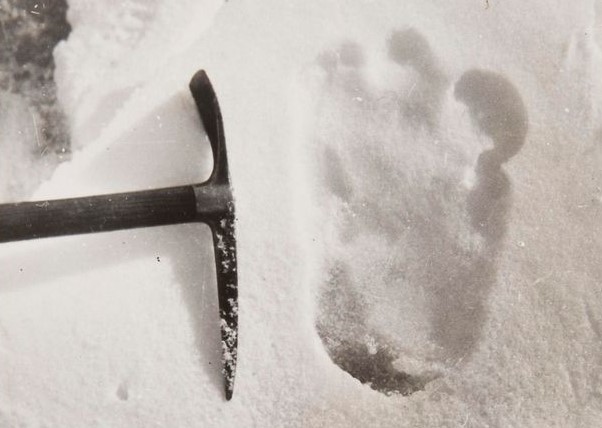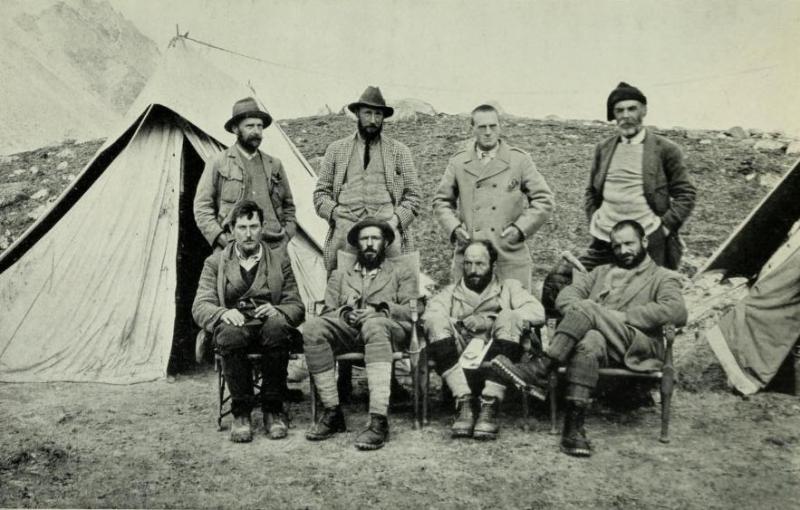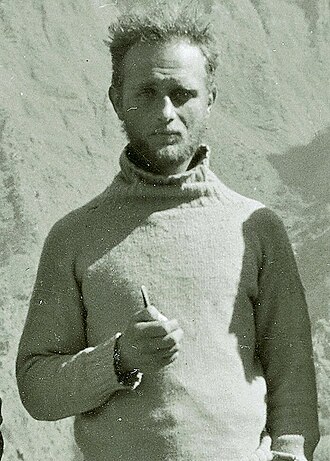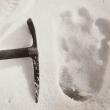The first European reports of the Abominable Snowman or yeti (as the Sherpas called it) came from the 1921 British Mount Everest reconnaissance expedition led by Charles Howard-Bury. The climbing team set off to explore how it might be possible to get to the vicinity of Mount Everest, find possible routes for ascending the mountain, and – if possible – make the first ascent of the highest mountain in the world. The Lama of Rongbuk monastery warned the members of the expedition that five yeti haunted the glacier basin. Howard-Bury found the tracks that resembled human footprints, and although the porters unhesitatingly identified them as belonging to the yeti, Howard-Bury concluded that “these tracks...were probably caused by a large ‘loping’ grey wolf, which in the soft snow formed double tracks rather like those of a barefooted man.”
In 1936, the Snowman was again in the news. A traveler in the high Brahmaputra valley, at an altitude of some 16,000 feet, came upon “five sets of tracks which looked exactly as though made by a barefoot man.” This statement was followed by a similar one from another explorer who had seen comparable tracks near the source of the Ganges.
In 1937, British mountaineer Frank Smythe and his Sherpas were on a col of the central Himalayas at a little over 16,000 feet when they discovered “the imprints of a huge foot, apparently of a biped.” Again, the porters diagnosed the tracks of the yeti. Smythe measured and photographed them and then sent his findings to British zoologists, who declared that the tracks were those of a bear, Ursus arctos pruinosus.
But the question was far from settled. The next traveler who had returned from the Himalayas told how in the Karakoram mountains at the west end of the range he had seen tracks which were “roughly circular, about a foot in diameter, nine inches deep and eighteen inches apart. They lay in a straight line without any right or left stagger, nor was there any sign of overlap as would the case with a four-footed beast.”
While climbing up the Zemu glacier in the Kanchenjunga range in 1938, Bill Tilman spotted a relatively recent trail at about 19,000 feet. It went up, across the col, and then disappeared among the rocks on the other side. Tilman had been under the impression that he was the first to go that way, and was furious that someone else had beat him to it. Back at Darjeeling he took steps to find out who it was, but was surprised to discover no one had been anywhere near there. Then Tilman discovered that a similar mystery had puzzled a British major in the same spot the year before.
A book appeared telling of the strange experience of another explorer in the same Zemu region who had caught sight of something rather like a human form three hundred yards away: “It was going upward at walking pace, occasionally stopping to pull up young dwarf rhododendron shrubs. The figure stood out black against the snow and wore no clothing. A minute later it plugged into a thicket and vanished. Its tracks, similar in shape to human footprints, measured six or seven inches in length, nine inches in width and were twelve to eighteen inches apart. The marks of the five toes and the instep were clear, but not that of the heel.”
Then in 1951, while crossing the Menlung La pass, in the Gaurisankar range, Eric Shipton photographed unfamiliar tracks in the snow. They were double, showing that at least two creatures had passed that way. Shipton sent a report on this to The Times (London): “The tracks had mostly been blurred by the thaw into oval imprints, slightly longer and much wider than those left by our big climbing boots. But here and there where the snow covering the ice was thin, we came upon a well-preserved footprint of the creature. It showed three toes and a big toe of great size. One point was particularly interesting. The tracks crossed a crevasse and it was obvious that the creature had leapt across and used its toes to gain a foothold in the snow on the other side. We followed the tracks for nearly two miles down the glacier to where the ice is covered with moraine deposits. I had in the past encountered many of these strange tracks in various parts of the Himalayas and in the Karakoram, but I had never before found any so well-preserved.”
Some of these tracks still showed the lines on the sole of the foot delicately imprinted in the snow, which proved how recent the creature had passed. Sen Tenzing and the porter who were with Shipton immediately identified the tracks as those of yetis. Sen Tenzing claimed to have seen a yeti near Thyangboche monastery at the time of a religious festival. Under cover of trees the yeti had come to within twenty yards or so of the assembled pilgrims, and many had caught a glimpse of the creature. Sen Tenzing described it as semi-human, semi-animal, about five and a half feet tall, its body covered with reddish-brown hair, but hairless on the face.
These early details of Himalayan yeti sightings were taken from Everest: From the First Attempt to the Final Victory (1955, The John Day Company).
On a personal note, I have a Tibetan friend who witnessed a yeti as a child while attending a family picnic near a stream in the Himalayas. Dorjee gave me a Tibetan map that includes all of the natural animals living in Tibet, including Tibetan mastiff, yak, Tibetan antelope, snow leopard, kiang (wild ass), lynx, brown bear, argali, golden monkey, Himalayan tahr, gazelle, red deer, goral, Hanuman Langur, Bengal tiger, black-necked, snow cock, barhead goose, wild birds...and you guessed it, the yeti.
Do you have a spooky story? Maybe you grew up in a haunted house or saw a UFO? Perhaps you’ve encountered a Bigfoot on a lonely trail? If so, please contact me at lisa.f.matthews@gmail.com - I’d love to hear your story. And if you enjoy mysterious stories like the ones featured in the 13 Days of Halloween Tales of Terror, look for our Mysterious Harbor Electric Bike and Walking Tours starting in Spring 2024.
 Yeti footprint photographed by Eric Shipton in 1951.
Yeti footprint photographed by Eric Shipton in 1951.
 The 1921 British Mount Everest reconnaissance expedition.
The 1921 British Mount Everest reconnaissance expedition.
 Arguably the greatest explorer and adventurer the twentieth century produced, Bill Tilman was in his 80th year when he disappeared in Antarctic waters in 1977.
Arguably the greatest explorer and adventurer the twentieth century produced, Bill Tilman was in his 80th year when he disappeared in Antarctic waters in 1977.
 Eric Shipton, the world’s most distinguished explorer of mountainous regions.
Eric Shipton, the world’s most distinguished explorer of mountainous regions.




























